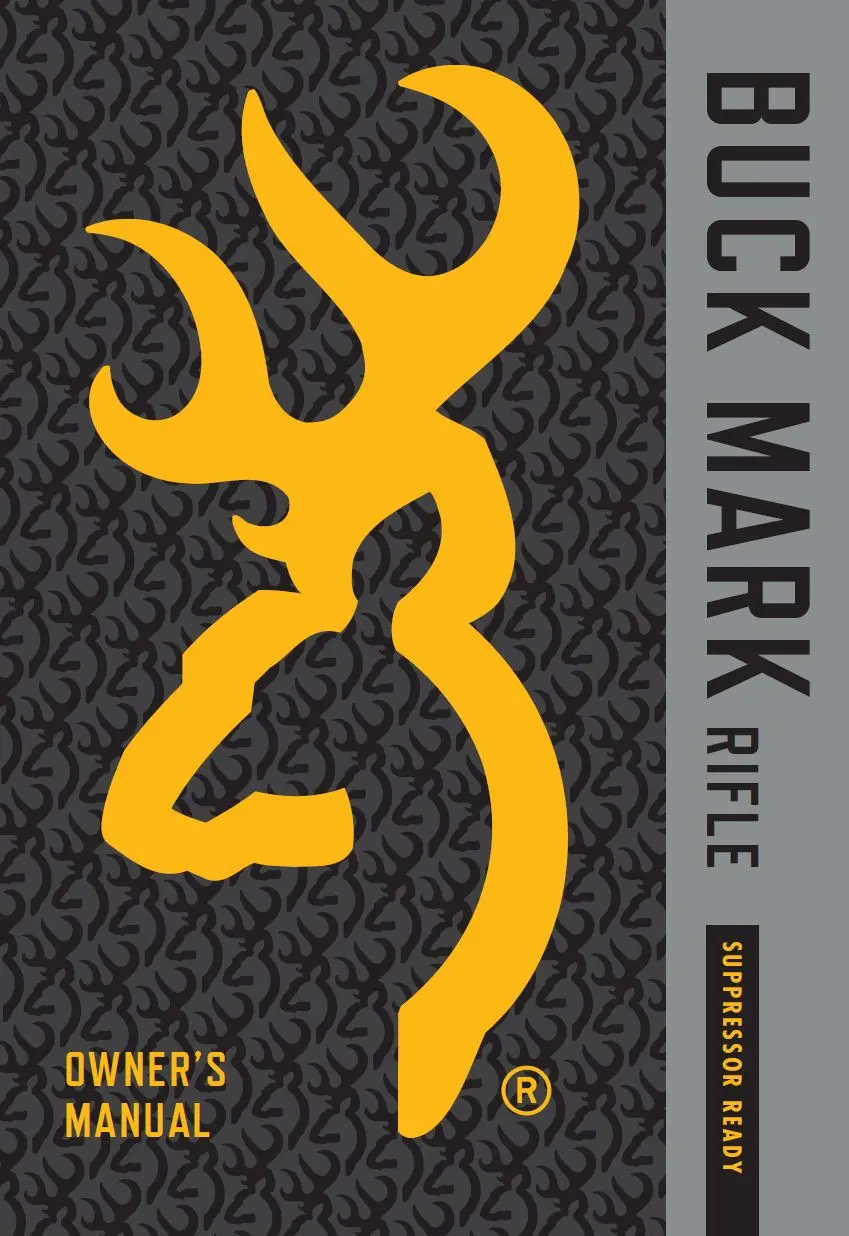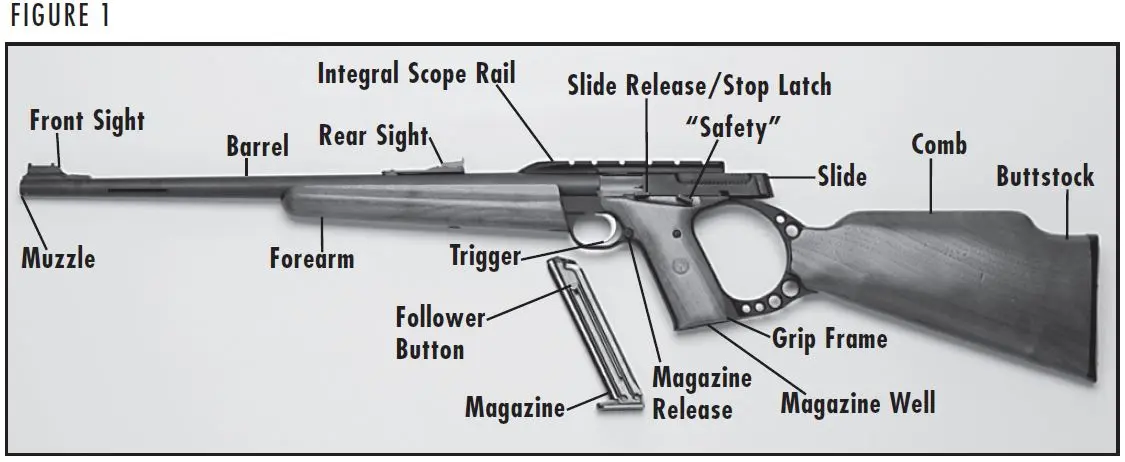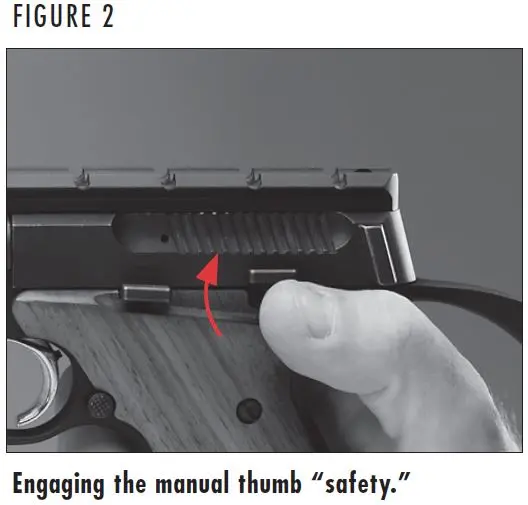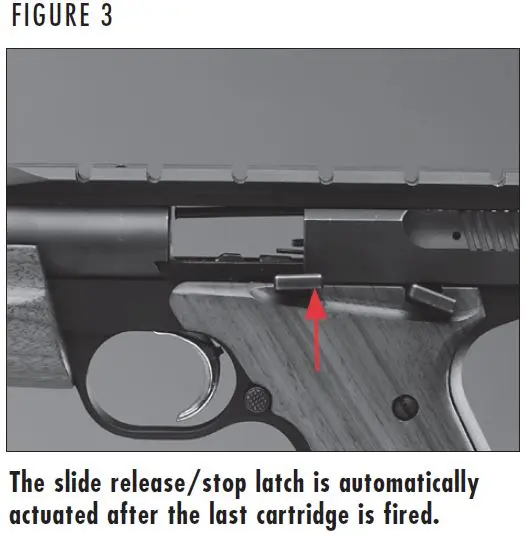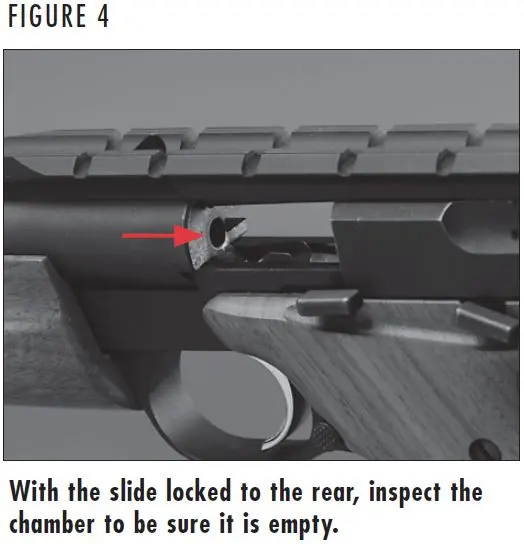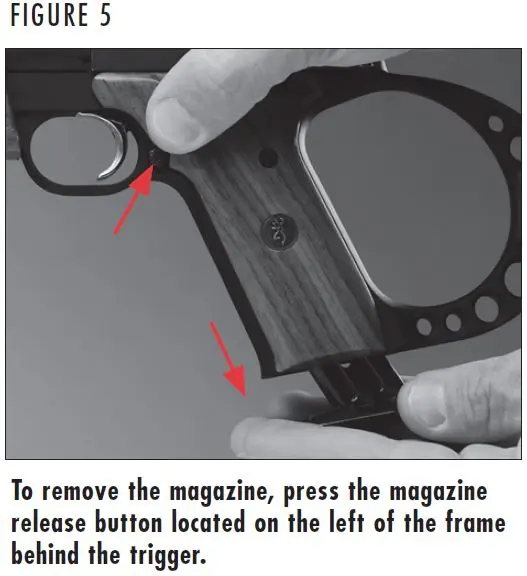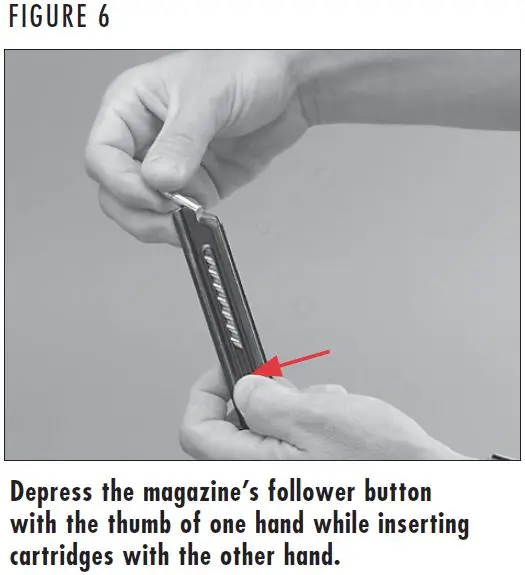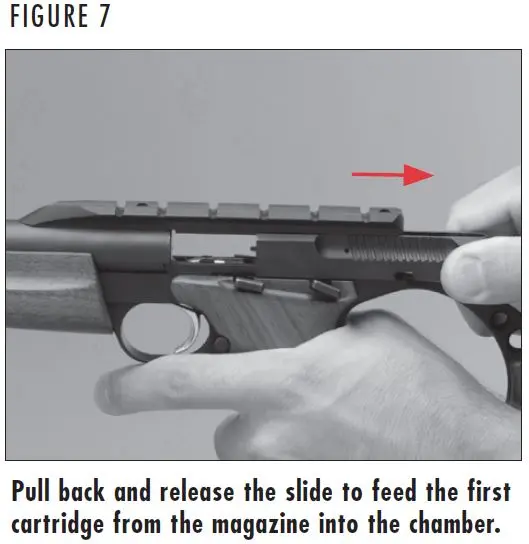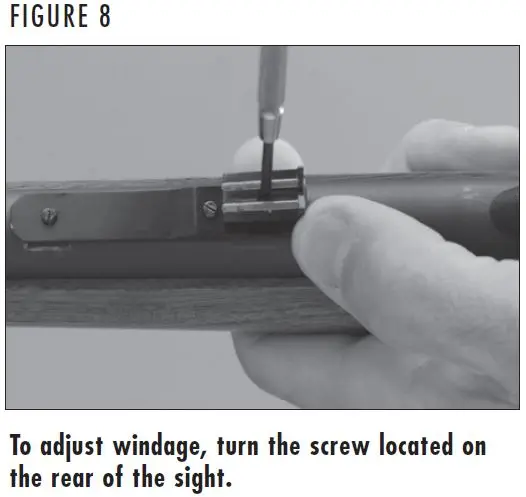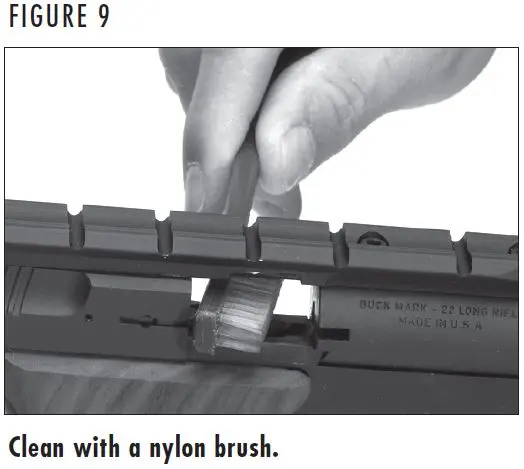Browning Buck Mark Rifle Owner's Manual
Browning Buck Mark Rifle Owner's Manual
Important operating instructions for: Browning Buck Mark Rifle.
If you have any questions about your new firearm, this owner’s manual or other Browning products, contact:
Browning Consumer Information
One Browning Place
Morgan, UT 84050-9326
Phone: (800) 333-3288
browning.com
Please use the space below to record information about your new firearm.
Model __________________________________________________
Serial Number ____________________________________________
Purchased From __________________________________________
Date of Purchase __________________________________________
THANK YOU FOR CHOOSING BROWNING.
In every sense, the Buck Mark Rifle is a true Browning. It gives you the kind of shooting enjoyment you’ve come to expect from the world’s most respected gun company. The Buck Mark Rifle is certainly a firearm you can be proud to own.
With a reasonable amount of care, your Buck Mark Rifle should give you many years of dependable, enjoyable service.
Specifications within this owner’s manual are correct at the time of printing and subject to change without notice.
NOTICE: DO NOT DRY FIRE THE BUCK MARK RIFLE. DRY FIRING MAY DAMAGE THE FIREARM COMPONENTS, POSSIBLY RENDERING THE FIREARM INOPERABLE.
You Are Responsible for Firearms Safety
STATE WARNING
According to state law, California requires that firearm manufacturers, distributors and retailers include conspicuous, specific warnings with firearms sold in that state.
Firearms must be handled responsibly and securely stored to prevent access by children and other unauthorized users.
California has strict laws pertaining to firearms, and you may be fined or imprisoned if you fail to comply with them. Visit the Web site of the California Attorney General at https://oag.ca.gov/firearms for information on firearm laws applicable to you and how you can comply.
Prevent child access by always keeping guns locked away and unloaded when not in use. If you keep a loaded firearm where a child obtains and improperly uses it, you may be fined or sent to prison.
Las armas de fuego deben de ser manipuladas responsablemente y almacenadas en sitios seguros para prevenir el acceso a ellas por parte de niños y personas sin autorización.
California cuenta con leyes estrictas sobre las armas de fuego, y puede ser multado y encarcelado si no las obedece. Visite la página web de California Attorney General, https://oag.ca.gov/firearms para más información sobre cómo cumplir con las leyes de armas de fuego.
Prevenga el acceso de los niños a las armas de fuego manteniéndolas siempre en un lugar seguro, bajo llave y descargadas cuando no estén en uso. Si usted deja un arma cargada al alcance de un niño, y éste la utiliza indebidamente,usted podría ser multado e incluso enviado a la cárcel.
WARNING: YOU ARE RESPONSIBLE FOR FIREARMS SAFETY
FAILURE TO FOLLOW ANY OF THE FOLLOWING WARNINGS COULD RESULT IN SERIOUS INJURY OR DEATH.
As a gun owner, you accept a set of demanding responsibilities. How seriously you take these responsibilities can be the difference between life and death.
There is no excuse for careless or abusive handling of any firearm. At all times handle this firearm and all other firearms with intense respect for their power and potential danger.
Please read and understand all of the cautions, warnings, notices, proper handling procedures and instructions outlined in this owner’s manual before using your new firearm.
1 - ALWAYS KEEP THE MUZZLE OF YOUR FIREARM POINTED IN A SAFE DIRECTION EVEN THOUGH YOU ARE CERTAIN IT IS UNLOADED. Never point any firearm at anything you do not intend to shoot. Be extremely alert and aware of all persons and property within the range of your ammunition.
2 - NEVER RELY TOTALLY ON YOUR FIREARM'S MECHANICAL “SAFETY” DEVICE. LIKE ANY MECHANICAL DEVICE, A "SAFETY" CAN SOMETIMES FAIL; IT CAN BE JARRED OR INADVERTENTLY MANIPULATED INTO AN UNSAFE CONDITION. The word, “safety,” describes a firearm’s trigger block mechanism, sear block mechanism, hammer block mechanism, or firing pin block mechanism. Mechanical “safeties” are designed to place your firearm in a safer status, and no guarantee can be made that the firearm will not fire even if the “safety” is in the on safe position. Mechanical “safeties” merely aid safe gun handling and are no excuse for pointing your firearm’s muzzle in an unsafe direction. See “Operation of the Safety” section below for instructions on the operation of this firearm’s “safety.”
Remember, safe gun handling does not stop with your firearm’s mechanical “safety” devices, it starts there. Always treat this firearm with the respect that you would a loaded, ready-to-fire firearm.
Some firearms do not have a mechanical safety. Many target firearms, lever-action firearms, and pistols do not have manual “safety” mechanisms. Therefore it is critical to read and understand the owner’s manual for every firearm which explains the safe operation of the firearm.
While it is a good idea to “test” your firearm’s mechanical “safety” periodically for proper function, never test the “safety” while your firearm is loaded or pointed in an unsafe direction.
3 - WHENEVER YOU HANDLE ANY FIREARM, OR HAND IT TO SOMEONE, ALWAYS OPEN THE ACTION IMMEDIATELY AND VISUALLY CHECK THE FIREARM'S CHAMBER TO MAKE CERTAIN THAT THE FIREARM IS COMPLETELY UNLOADED. Make certain the firearm does not inadvertently contain any ammunition. Remember, merely removing the magazine does not mean the chamber is unloaded. Always keep the chamber empty and the “safety” in the on safe position unless shooting is imminent.
4 - ALWAYS WEAR EAR AND EYE PROTECTION WHEN SHOOTING. Unprotected, repeated exposure to gunfire can cause hearing damage. Wear hearing protection (shooting ear plugs or muffs) to guard against such damage.
Wear shooting glasses to protect your eyes from flying particles. Allow proper distance (eye relief) between a scope and your eye when firing a scoped pistol, rifle or shotgun. Do not use unorthodox shooting methods that could cause the rearward travel of the slide or bolt of a firearm to contact your eyes, face or hands. Always keep a safe distance between the muzzle of your firearm and any persons nearby, as muzzle blast, debris and ejecting cartridges could inflict serious injury.
Always wear eye protection when disassembling and cleaning any firearm to prevent the possibility of springs, spring-tensioned parts, solvents or other agents from contacting your eyes.
5 - KEEP ALL FIREARMS UNLOADED DURING TRANSPORT, EVEN WHEN STORED IN A HOLSTER, GUN CASE, SCABBARD, OR OTHER CONTAINER.
6 - DROPPING OR JARRING A LOADED FIREARM CAN CAUSE ACCIDENTAL DISCHARGE. This can occur even with the “safety” in the on safe position. Be extremely careful while hunting or during any shooting activity to avoid dropping any firearm.
7 - HUNTING FROM ELEVATED SURFACES SUCH AS TREESTANDS IS DANGEROUS. Doing so may increase the risk of mishandling a firearm. The following rules should always be observed by you and those you hunt with: Always make certain that the stand being used is safe and stable. Always make certain that your firearm is unloaded when it is being taken up and down from the stand. Always make certain that your firearm is not dropped from the stand, or dropped while it is being taken up or down from the stand. Remember, a loaded firearm may discharge when dropped, even with the “safety” in the on safe position.
8 - STORE YOUR FIREARM AND AMMUNITION SEPARATELY, WELL BEYOND THE REACH OF CHILDREN. Take prudent safeguards to ensure your firearm does not become available to untrained, inexperienced or unwelcome hands. Store all firearms in secure, locked cases or a gun safe. Keep your firearm unloaded when not in use.
9 - BEWARE BARREL OBSTRUCTIONS. Mud, snow and an infinite variety of other objects may inadvertently lodge in a barrel bore. It only takes a small obstruction to cause dangerously increased pressures that can damage your firearm and cause serious injury to yourself and others..
BEFORE CHECKING FOR A BARREL OBSTRUCTION, BE CERTAIN YOUR FIREARM IS COMPLETELY UNLOADED, THERE IS NOT A LIVE CARTRIDGE IN THE CHAMBER AND THE “SAFETY” IS IN THE ON SAFE POSITION.
After assuring yourself that the firearm is completely unloaded, open the breech or action and look through the barrel to be sure it is clear of obstructions. If an obstruction is seen, no matter how small it may be, clean the bore with a cleaning rod and patch as described in the Cleaning and Maintenance section of this owner’s manual.
10 - BE ALERT TO THE SIGNS OF AMMUNITION MALFUNCTION. IF YOU DETECT AN OFF SOUND OR LIGHT RECOIL WHEN A CARTRIDGE IS FIRED, DO NOT LOAD ANOTHER CARTRIDGE INTO THE CHAMBER.
If your firearm fails to fire, keep the muzzle pointed in a safe direction for a minimum of 30 seconds. Rotate the ejection area of the firearm away from you, carefully open the action and remove the cartridge from the chamber. If the primer is indented, the defective cartridge should be disposed of in a way that cannot cause harm. If the primer is not indented, your firearm should be examined by a qualified gunsmith and the cause of the malfunction corrected before further use. Glance down the barrel to make sure that no obstructions remain in the barrel. Completely clear the barrel before loading and firing again. Failure to follow these instructions can cause extensive damage to your firearm and possible serious injury to yourself and others.
11 - NEVER INSERT A CARTRIDGE OF THE INCORRECT CALIBER INTO ANY FIREARM. The caliber of your firearm is marked on the barrel. Store all cartridges of different calibers in completely separate and well-marked containers. Never store cartridges of mixed calibers in a common container or in your pockets. See the ammunition section below for more information on the correct ammunition for your firearm.
12 - EXAMINE EVERY CARTRIDGE YOU PUT IN YOUR FIREARM.
We cannot assume any responsibility for the use of unsafe or improper firearm and ammunition combinations or damage or injury caused by damaged ammunition. It is your responsibility to read and heed all warnings in this owner’s manual and on ammunition boxes. See the ammunition section below for more information on the correct ammunition for your firearm.
13 - USE ONLY SAAMI APPROVED AMMUNITION.
The barrel and action of this firearm have been made with substantial safety margins beyond the pressures developed by established American commercial loads. Nevertheless, we can assume no liability for incidents that occur through the use of cartridges of nonstandard dimensions or which develop pressures in excess of commercially available ammunition which have been loaded in accordance with standards established by the Sporting Arms and Ammunition Manufacturers’ Institute (SAAMI).
14 - DISCHARGING FIREARMS IN POORLY VENTILATED AREAS, CLEANING FIREARMS OR HANDLING AMMUNITION MAY RESULT IN EXPOSURE TO LEAD AND OTHER SUBSTANCES KNOWN TO CAUSE BIRTH DEFECTS, REPRODUCTIVE HARM AND OTHER SERIOUS PHYSICAL INJURY. HAVE ADEQUATE VENTILATION AT ALL TIMES. WASH HANDS THOROUGHLY AFTER EXPOSURE.
15 - DO NOT SNAP THE FIRING PIN ON AN EMPTY CHAMBER, THE CHAMBER MAY NOT BE EMPTY!
Treat every firearm with the respect due a loaded firearm, even though you are certain the firearm is unloaded.
16 - KEEP YOUR FINGERS AWAY FROM THE TRIGGER WHILE LOADING AND UNLOADING UNTIL SHOOTING IS IMMINENT.
17 - BE SURE OF YOUR TARGET AND BACKSTOP, PARTICULARLY DURING LOW LIGHT PERIODS. Know the range of your ammunition. Never shoot at water or hard objects.
18 - ALWAYS UNLOAD YOUR FIREARM'S CHAMBER BEFORE CROSSING A FENCE, CLIMBING A TREE, JUMPING A DITCH OR NEGOTIATING OTHER OBSTACLES. Never place your firearm on or against a fence, tree, car, or other similar object.
19 - BE DEFENSIVE AND ON GUARD AGAINST UNSAFE GUN HANDLING AROUND YOU AND OTHERS. Don’t be timid when it comes to firearm safety. If you observe other shooters violating any of these safety precautions, politely suggest safer handling practices.
20 - BE CERTAIN YOUR FIREARM IS UNLOADED BEFORE CLEANING. Special and extreme care should be taken to be sure your firearm is unloaded before disassembly, cleaning and reassembly. Keep ammunition away from the cleaning location. Never test the mechanical function of any firearm with live ammunition.
21 - TEACH AND SUPERVISE FIREARMS SAFETY TO ALL MEMBERS OF YOUR FAMILY, ESPECIALLY TO CHILDREN AND NON-SHOOTERS. Closely supervise newcomers to the shooting sports. Encourage enrollment in hunting and shooting safety courses.
22 - NEVER DRINK ALCOHOLIC BEVERAGES OR TAKE ANY TYPE OF DRUGS BEFORE OR DURING SHOOTING. Your vision, motor skills, and judgment could be dangerously impaired, making your gun handling unsafe to you and to others.
23 - READ AND HEED ALL WARNINGS IN THIS OWNER'S MANUAL, ON AMMUNITION BOXES, AND WITH ALL ACCESSORIES THAT YOU INSTALL ON YOUR FIREARM. It is your responsibility to secure the most up-to-date information on the safe handling procedures of your Browning firearm. We assume no liability for incidents that occur when unsafe or improper firearm accessories or ammunition combinations are used.
24 - PRACTICE PERIODIC MAINTENANCE, AVOID UNAUTHORIZED SERVICING. Your firearm is a mechanical device that will not last forever, and as such, is subject to wear and requires periodic inspection, adjustment and service. Browning firearms should be serviced by a Browning Recommended Service Center or by our Service Facility in Arnold, Missouri. We cannot assume any responsibility for injuries suffered or caused by unauthorized servicing, alterations or modifications of Browning firearms.
25 - DO NOT, UNDER ANY CIRCUMSTANCES, ALTER THE TRIGGER, "SAFETY" OR OTHER PARTS OF THE FIRING MECHANISM OF THIS OR ANY OTHER FIREARM EXCEPT AS OTHERWISE DESCRIBED IN THIS MANUAL.
WE RESERVE THE RIGHT TO REFUSE SERVICE ON FIREARMS THAT HAVE BEEN ALTERED, ADDED TO OR SUBSTANTIALLY CHANGED. Removal of metal from the barrel, or modifications of the firing mechanism and/or operating parts, may lead to a refusal of service on such firearms. You will be charged for parts and labor to return the firearm to original specifications prior to servicing your firearm.
With respect to AFTERMARKET PARTS OR COMPONENTS (including, for example, aftermarket trigger systems, barrels, muzzle brakes, suppressors, magazines, etc.), USE AT YOUR OWN RISK. Browning firearms are designed and engineered to meet stringent safety standards. Browning is not responsible for personal injuries or property damage caused by alterations to a firearm. This includes the incorporation of aftermarket parts or components that may or may not satisfy Sporting Arms and Ammunition Manufacturers’ Institute (SAAMI) standards (for example, an aftermarket trigger system may not satisfy SAAMI minimum trigger pull standards, etc.) or may create other dangerous conditions. These conditions may or may not be apparent to the user (for example, installing an aftermarket barrel may have the effect of altering critical firearm dimensions, including headspace, and may create an unsafe firing condition, etc.). Aftermarket parts or components that do not satisfy SAAMI standards, or that could create other dangerous conditions, should not be used.
FAILURE TO FOLLOW THIS WARNING COULD RESULT IN SERIOUS INJURY OR DEATH, AS WELL AS CAUSE DAMAGE TO YOUR FIREARM.
BE CAREFUL!
BE CAREFUL!
GENERAL DESCRIPTION AND OPERATION
The Browning Buck Mark Rifle is a single-action autoloading rifle that utilizes a straight blow-back, recoil-operated design for simplicity and reliability. Cartridges are fed from a removable magazine that makes loading the rifle fast and easy. With the chamber and magazine loaded and the “safety” in the off safe or fire position, the rifle will fire a single cartridge with each successive pull of the trigger until the chamber and magazine are empty. The slide of the rifle is designed to stay open after the last cartridge has been fired. The frame is made from CNC-machined 7075-T6 aluminum to ensure tight, consistent parts fit and excellent reliability.
NOTICE: DO NOT DRY FIRE THE BUCK MARK RIFLE. DRY FIRING MAY DAMAGE THE FIREARM COMPONENTS, POSSIBLY RENDERING THE FIREARM INOPERABLE.
NOMENCLATURE
In conventional firearm terminology, the position and movement of parts are described as they occur with the rifle horizontal and in normal firing position; i.e. the muzzle is forward or front; the sights are upward or on top. For general nomenclature refer to Figure 1. General functions and procedures are described and illustrated using a Buck Mark Sporter Rifle. Procedures unique to individual models are discussed separately.
SERIAL NUMBER
The serial number of your Buck Mark Rifle can be found stamped on the left side of the rifle frame, in front of the trigger guard.
Operation of the "Safety"
Operation of the "Safety"
The Buck Mark Rifle incorporates a manual thumb-operated, sear blocking “safety.” To put the mechanism on safe, the slide must be fully forward with the hammer cocked. The manual thumb “safety” lever is then pushed upward into the recess provided for it in the slide (Figure 2). Note: This may require firm pressure. Be sure the lever travels to its maximum upward movement and is completely engaged in the recess. Although the sear is now blocked, abusive handling such as a sharp blow could dislodge the hammer or otherwise cause the firing pin to move forward and discharge a cartridge.
SLIDE RELEASE / STOP LATCH
SLIDE RELEASE / STOP LATCH
The slide release / stop latch is on the left side of the slide, above the magazine release (Figure 3). It automatically engages after the last cartridge in the magazine has been fired. It can also be used to lock the slide in the rearward position when the magazine is removed.
To engage the slide release/stop latch, pull the slide completely rearward and push upward on the slide release/stop latch.
To release the slide when no magazine is in the rifle and the slide is locked rearward, press the slide release/stop latch downward. When pressed, the slide is released and will close under spring pressure.
WARNING: MAKE SURE YOUR FINGERS ARE SAFELY AWAY FROM THE CHAMBER WHEN THE SLIDE IS RELEASED TO AVOID PINCHING THEM WHEN THE SLIDE CLOSES.
INITIAL CLEANING
INITIAL CLEANING
CLEANING
Various exposed metal parts of your new firearm have been coated at the factory with a rust preventative compound. Before firing your rifle, clean the anti-rust compound from the inside of the barrel, receiver and the action-chamber areas. A fine, light gun oil is ideal for removing this compound and for giving your new firearm its first lubrication. However, any quality firearm oil may be used. Clean the barrel using a cleaning rod and patch as explained under the “Cleaning and Maintenance Suggestions” section below. If your Buck Mark Rifle is to be stored, it is acceptable to leave the rust preventative compound on the rifle and keep it in its original packaging.
NOTICE: NEVER ATTEMPT TO TAKE YOUR FIREARM APART FURTHER THAN EXPLAINED IN THIS OWNER’S MANUAL. YOUR FIREARM IS A SPECIALIZED, FINELY FITTED MECHANISM. YOU MAY PERMANENTLY DAMAGE IT BY ATTEMPTING TO DISASSEMBLE THE INNER MECHANISM ASSEMBLIES. IF FURTHER DISASSEMBLY FOR SERVICE OR CLEANING IS REQUIRED, TAKE YOUR FIREARM TO A QUALIFIED GUNSMITH, OR CONTACT OUR ARNOLD, MISSOURI SERVICE FACILITY AS EXPLAINED UNDER THE “SERVICE OR REPAIR” SECTION.
Ammunition
Ammunition
The barrel and action of this firearm have been made with safety margins over the pressures established by the Sporting Arms and Ammunition Manufacturers’ Institute (SAAMI) for Service Cartridges. However, we assume no responsibility for incidents which occur through the use of cartridges of nonstandard dimension or those developing pressures in excess of SAAMI established standards.
The SA-22 must be used only with 22 Long Rifle rimfire ammunition as designated on the barrel.
Magazine Capacity
Magazine Capacity
The magazine capacity of the Buck Mark Rifle is 10 cartridges.
WARNING: WHEN LOADING YOUR RIFLE ALWAYS KEEP THE MUZZLE POINTED IN A SAFE DIRECTION, THE “SAFETY” IN THE ON SAFE POSITION, AND YOUR FINGERS AWAY FROM THE TRIGGER. FAILURE TO FOLLOW THESE WARNINGS COULD RESULT IN SERIOUS INJURY OR DEATH.
Loading
Loading
REMOVING AND LOADING THE MAGAZINE
1. Inspect the chamber to be sure it is empty (Figure 4).
2. Pull the slide rearward and push the slide release/stop latch up to lock the slide to the rear.
3. Remove the magazine from the rifle by pressing the magazine release button with your thumb (Figure 5).
4. With the chamber empty, close the slide using the slide release / stop latch. To reduce the chance of inadvertently feeding a cartridge into the chamber from the magazine, always close the slide using the slide release/stop latch and place the “safety” in the on safe position before inserting a loaded magazine.
5. Place the “safety” up into the on safe position.
6. Load the magazine by sliding the magazine follower button located on the side of the magazine down with the thumb of one hand while inserting the cartridges with the other hand (Figure 6).
LOADING THE RIFLE
1. Insert the loaded magazine into the rifle, being certain that the magazine is pressed completely in and is being retained by the magazine latch.
2. Slide the “safety” lever down into the off safe position.
3. Pull the slide completely back and release the slide. It will move forward under spring pressure and feed the first cartridge from the magazine into the chamber (Figure 7).
WARNING: THE RIFLE IS NOW READY TO FIRE. UNLESS SHOOTING IS IMMINENT, IMMEDIATELY RETURN THE “SAFETY” TO THE ON SAFE POSITION. FAILURE TO FOLLOW THESE WARNINGS COULD RESULT IN SERIOUS INJURY OR DEATH.
SINGLE-SHOT LOADING
If you wish to use your Buck Mark Rifle as a single-shot rifle, as when teaching a newcomer how to shoot, it is recommended that you use the following procedure.
1. Pull the slide rearward and push the slide release/stop latch up to lock the slide to the rear. Inspect the chamber to be sure it is empty (Figure 4).
2. Remove the magazine from the rifle by pressing the magazine release button (Figure 5).
3. With the chamber empty, close the slide by pushing the slide release/stop latch downward. To reduce the chance of inadvertently feeding a cartridge into the chamber from the magazine, close the slide by pushing the slide release/stop latch down and place the “safety” in the on safe position before inserting a loaded magazine.
4. Place the “safety” up into the on safe position.
5. Load a single cartridge into the magazine.
6. Insert the magazine into the rifle, be certain that the magazine is pressed completely in and is retained by the magazine latch.
7. When ready to fire, slide the “safety” lever down into the off safe position.
8. Pull the slide completely back and release it. It will move forward under spring pressure and feed the cartridge from the magazine into the chamber.
WARNING: THE RIFLE IS NOW READY TO FIRE. UNLESS SHOOTING IS IMMINENT, IMMEDIATELY RETURN THE “SAFETY” TO THE ON SAFE POSITION. FAILURE TO FOLLOW THESE WARNINGS COULD RESULT IN SERIOUS INJURY OR DEATH.
WARNING: NEVER CHAMBER A CARTRIDGE OR MOVE THE “SAFETY” FROM THE ON SAFE POSITION UNLESS SHOOTING IS IMMINENT. ALWAYS KEEP THE MUZZLE POINTED IN A SAFE DIRECTION. FAILURE TO FOLLOW THESE WARNINGS COULD RESULT IN SERIOUS INJURY OR DEATH.
DO NOT USE UNORTHODOX SIGHTING METHODS. YOU WILL HAVE OBSERVED WHEN COCKING THE RIFLE THAT THE SLIDE MOVES REARWARD ABOUT ONE INCH PAST THE REAR OF THE FRAME. TO PREVENT THE SLIDE FROM CAUSING INJURY IN ITS REARWARD MOVEMENT WHEN YOU ARE SHOOTING, KEEP THE RIFLE AWAY FROM THE EYES OR FACE, AND NEITHER HAND SHOULD BE IN A POSITION WHERE IT COULD BE HIT BY THE SLIDE.
Firing
Firing
1. Load a cartridge into the chamber as explained previously. Immediately place the “safety” in the on safe position.
2. With a cartridge in the chamber, you need only move the “safety” to the off safe position to make the rifle ready for firing.
3. When ready to fire, move the “safety” down into the off safe position, take aim and squeeze the trigger.
After a cartridge has been fired, the slide moves rearward, ejects the empty case, then returns forward, loading a cartridge from the magazine. You may continue to fire the rifle until the magazine is empty by pulling the trigger to fire each cartridge. After the last cartridge is fired, the slide release/stop latch automatically holds the slide in its open or rearward position. If firing is no longer imminent, remove the magazine and close the slide by pushing down on the slide release/stop latch.
WARNING: AFTER THE LAST CARTRIDGE HAS BEEN FIRED, OR WHEN SHOOTING IS NO LONGER IMMINENT, IMMEDIATELY PLACE THE “SAFETY” IN THE ON SAFE POSITION. FAILURE TO FOLLOW THESE WARNINGS COULD RESULT IN SERIOUS INJURY OR DEATH.
4. If the magazine is empty and you wish to continue shooting, follow the instructions in the “Loading” section. If you are finished shooting, follow the instructions in the “Unloading” section.
When reloading the rifle, it is recommended that you inspect the chamber to be sure it is empty, then close the slide and place the manual thumb “safety” in the on safe position.
To reduce the chance of inadvertently feeding a cartridge into the chamber from the magazine, always close the slide using the slide release/stop latch and place the “safety” in the on safe position before inserting a loaded magazine.
If your Buck Mark Rifle is to be put away and stored, do not insert a loaded magazine in the rifle. The chamber and magazine should remain empty.
WARNING: WHILE UNLOADING YOUR RIFLE ALWAYS KEEP THE MUZZLE POINTED IN A SAFE DIRECTION, AND YOUR FINGERS AWAY FROM THE TRIGGER. FAILURE TO FOLLOW THESE WARNINGS COULD RESULT IN SERIOUS INJURY OR DEATH.
Unloading
Unloading
UNLOADING THE RIFLE
- Depress the magazine release and remove the magazine. Remember, merely removing the magazine does not mean the chamber is unloaded.
- Slide the manual thumb “safety” down into the off safe position.
- Pull back on the slide and eject the cartridge in the chamber. Lock the slide to the rear by sliding the slide release/stop latch up.
- Inspect the chamber to ensure no cartridge is present.
- When you are certain your rifle is fully unloaded, push down on the slide release/stop latch and allow the slide to return forward.
- Place the “safety” in the on safe position.
UNLOADING THE MAGAZINE
- Depress the magazine release and remove the magazine. Remember, merely removing the magazine does not mean the chamber is unloaded.
- Unload the rifle as explained previously, make sure the chamber is completely unloaded.
- Strip the cartridges from the magazine by pushing forward on the rim of the top cartridge and sliding each cartridge out, one at a time, as each moves up in the magazine.
- Unload any extra magazines.
Dry Firing
Dry Firing
WARNING: BEFORE PERFORMING SIGHT ADJUSTMENT PROCEDURES, MAKE SURE YOUR RIFLE IS COMPLETELY UNLOADED. REMOVE THE MAGAZINE, CHECK THE ACTION AND CHAMBER FOR CARTRIDGES. KEEP THE MUZZLE POINTED IN A SAFE DIRECTION. FAILURE TO FOLLOW THESE WARNINGS COULD RESULT IN SERIOUS INJURY OR DEATH.
Sight Adjustment
Sight Adjustment
The tapered-barreled Buck Mark Sporter Rifle comes with an integral scope mount and high-visibility fiber-optic sights. While the sight on your rifle may vary slightly, the adjustment procedure is the same. No adjustment of the front sight is necessary. Adjust the rear sight as follows:
- Windage: Adjustments are made by loosening the rear screw (Figure 8) and sliding the sight assembly to the left or right by hand. Be sure to tighten the screw after adjusting. Move the sight assembly in the direction you would like the point of impact to move.
- Elevation: Adjust using the middle screw. To raise the point of impact, turn clockwise. To lower the point of impact, turn counterclockwise.
NOTICE: USE ONLY A DAMP CLOTH TO CLEAN THE FIBER OPTIC LIGHT PIPES. USE OF SOLVENTS OR OTHER CHEMICALS COULD DAMAGE THE FIBER-OPTIC LIGHT PIPES.
WARNING: BEFORE INSTALLING A SCOPE OR OPTICAL SIGHT, MAKE SURE YOUR RIFLE IS COMPLETELY UNLOADED. REMOVE THE MAGAZINE, CHECK THE ACTION AND CHAMBER FOR CARTRIDGES. KEEP THE MUZZLE POINTED IN A SAFE DIRECTION. FAILURE TO FOLLOW THESE WARNINGS COULD RESULT IN SERIOUS INJURY OR DEATH.
MOUNTING A SCOPE
MOUNTING A SCOPE
Some Buck Mark Target Rifles include an integral scope rail intended to be used with a scope or electronic sight (sold separately). Be sure to follow manufacturers’ mounting instructions that are included with any accessories you install on your rifle.
WARNING: THE ADDITION OF A RECOIL REDUCING MUZZLE BRAKE SIGNIFICANTLY INCREASES NOISE AND MUZZLE BLAST. YOU, AND EVERYONE IN CLOSE PROXIMITY TO THE FIREARM, SHOULD ALWAYS WEAR HEARING PROTECTION TO HELP PREVENT HEARING LOSS OR DAMAGE AND SAFETY GLASSES TO HELP PREVENT DEBRIS FROM INJURING THE EYES.
WARNING: WHEN USING A SUPPRESSOR, ALWAYS WEAR HEARING AND EYE PROTECTION. EVEN THOUGH SOUND IS REDUCED WHEN USING A SUPPRESSOR, THE NOISE LEVELS ARE STILL SIGNIFICANT ENOUGH TO CAUSE PERMANENT HEARING LOSS. BE AWARE THAT USING A SUPPRESSOR INCREASES THE BACK PRESSURE IN THE BARREL WHEN A CARTRIDGE IS FIRED. THE INCREASE IN BACK PRESSURE MAY CAUSE DEBRIS FROM THE CARTRIDGE TO EXIT THE EJECTION PORT OF THE FIREARM AND CONTACT YOUR EYES, EARS AND FACE, OR THOSE OF ANYONE IN CLOSE PROXIMITY TO THE FIREARM. THE INCREASE IN BACK PRESSURE MAY ALSO RESULT IN THE DEPOSIT OF ADDITIONAL DEBRIS IN YOUR FIREARM; ACCORDINGLY, AN ACCELERATED CLEANING SCHEDULE FOR YOUR FIREARM MAY BE NECESSARY.
WARNING: ENSURE THAT ANY MUZZLE BRAKE OR SUPPRESSOR THAT YOU INTEND TO USE ON YOUR FIREARM IS DESIGNED FOR USE WITH YOUR FIREARM’S CALIBER. NEVER USE A MUZZLE BRAKE OR SUPPRESSOR THAT IS DESIGNED FOR RIMFIRE USE ONLY ON A CENTERFIRE FIREARM. BEFORE INSTALLING OR REMOVING A MUZZLE BRAKE OR SUPPRESSOR TO/FROM YOUR FIREARM, READ THIS OWNER’S MANUAL AND ANY OWNER’S MANUAL INCLUDED WITH THE DEVICE, AND PRECISELY FOLLOW ALL INSTALLATION AND MAINTENANCE INSTRUCTIONS PROVIDED BY THE SUPPRESSOR OR MUZZLE BRAKE MANUFACTURER. DURING INSTALLATION OR REMOVAL, ALWAYS KEEP THE MUZZLE POINTED IN A SAFE DIRECTION AND MAKE CERTAIN THAT THE FIREARM IS COMPLETELY UNLOADED, WITH THE MAGAZINE REMOVED AND THE ACTION IN THE OPEN POSITION. WARNING: KEEP ALL AMMUNITION AWAY FROM THE CLEANING AREA. NEVER TEST THE MECHANICAL FUNCTION OF YOUR RIFLE WITH LIVE AMMUNITION. FAILURE TO FOLLOW THESE WARNINGS COULD RESULT IN SERIOUS INJURY OR DEATH.
WARNING: PERIODICALLY CHECK THE MUZZLE BRAKE OR SUPPRESSOR TO ASSURE THAT IT IS TIGHT AND FIRMLY SEATED. BEFORE CHECKING, FOLLOW ALL SAFETY GUIDELINES PREVIOUSLY OUTLINED. ENSURE THE MUZZLE BRAKE OR SUPPRESSOR IS COOL BEFORE TOUCHING IT.
FAILURE TO FOLLOW THESE WARNINGS MAY RESULT IN INJURY OR DEATH TO YOU OR THOSE AROUND YOU!
MUZZLE BRAKES AND SUPPRESSORS
MUZZLE BRAKES AND SUPPRESSORS
Most Browning rifles equipped with a muzzle brake also include a thread protector that can be installed in place of the muzzle brake. Whether using the thread protector, muzzle brake or suppressor, be aware that your firearm’s point of impact may change as the harmonics of the barrel are affected when changing the weight at the end of the barrel.
WARNING: BEFORE PERFORMING CLEANING PROCEDURES, MAKE SURE THE MAGAZINE IS REMOVED FROM THE FIREARM AND THE CHAMBER IS COMPLETELY UNLOADED. PLACE THE “SAFETY” IN THE ON SAFE POSITION. ALWAYS KEEP THE MUZZLE POINTED IN A SAFE DIRECTION. FAILURE TO FOLLOW THESE WARNINGS COULD RESULT IN SERIOUS INJURY OR DEATH.
WARNING: WEAR EYE PROTECTION WHEN DISASSEMBLING AND CLEANING YOUR RIFLE TO PREVENT THE POSSIBILITY OF SPRINGS, SPRING-TENSIONED PARTS, SOLVENTS OR OTHER AGENTS FROM CONTACTING YOUR EYES, RESULTING IN INJURY.
WARNING: KEEP ALL AMMUNITION AWAY FROM THE CLEANING AREA. NEVER TEST THE MECHANICAL FUNCTION OF YOUR RIFLE WITH LIVE AMMUNITION. FAILURE TO FOLLOW THESE WARNINGS COULD RESULT IN SERIOUS INJURY OR DEATH.
Cleaning and Maintenance Suggestions
Cleaning and Maintenance Suggestions
CLEANING PROCEDURES
Your Buck Mark Rifle will function better and more reliably over a longer period of time if it is properly maintained and kept clean.
Clean your Buck Mark Rifle after every day of shooting, and more often if it becomes excessively dirty. A minimum cleaning includes wiping down the action and oiling key parts. Most regular maintenance will also include cleaning the barrel. If you encounter a function problem be sure to clean your firearm thoroughly to see if it solves the problem before seeking the services of a Browning Recommended Service Center or our Service Facility in Arnold, Missouri, or a qualified gunsmith.
NOTICE: DO NOT PLACE LARGE AMOUNTS OF OIL INTO THE ACTION. EXCESS OIL WILL RUN BACK INTO THE WOOD OF THE GRIPS (IF SO EQUIPPED) AND SOFTEN THE WOOD, WITH CONSEQUENTIAL LOOSENING OF THE GRIPS.
1. Pull the slide rearward and lock it open with the slide release / stop latch. Visually inspect the action and chamber to be certain they are empty.
2. Dip or spray a small, stiff-bristled nylon brush with a quality gun cleaning solvent and scrub the breech and face of the slide to remove build up (Figure 9).
WARNING: MOST SOLVENTS ARE HIGHLY FLAMMABLE. WEAR EYE PROTECTION AND PRACTICE APPROPRIATE SAFETY MEASURES WHEN WORKING WITH SOLVENTS TO AVOID SERIOUS INJURY.
3. Clean the bore using a rifle cleaning rod with a tip and a patch made for 22 caliber rifles. Ordinarily a lightweight high-quality gun oil will suffice for cleaning the bore. Carefully insert the rod and patch into the muzzle and run it back and forth several times. Do not allow the cleaning rod to strike the crown of the muzzle, as damage to this area can affect the accuracy of your rifle. Depending on the amount of use, the bore may need to be cleaned with a good quality nitro solvent. Inspect the chamber and bore for powder fouling. A normal amount of powder residue can be expected and is not serious. It can usually be removed with a patch saturated with nitro solvent. If, or when, fouling should become heavy, it can be removed with a brass bore brush. Dip or spray the brush with nitro solvent and scrub the chamber and bore until the fouling is removed. To prevent brass bristles from breaking off, the brush should be pushed completely through the barrel before being withdrawn.
Browning offers a complete line of products to make cleaning your firearm fast and easy. Be sure to follow all instructions when using any product to clean your firearm.
4. After all fouling has been removed, the chamber and bore should be wiped dry. Next pass a lightly oiled patch through the bore for preservation. A fine, light gun oil is recommended.
5. Use a small nylon brush to remove dirt or other foreign matter from the other parts of the action.
6. Lightly lubricate all moving parts, the frame where the slide contacts it and the spring guide with a high-quality, lightweight gun oil. Use oil sparingly, a very light film is sufficient. A fine, lightweight gun oil is ideally suited for this purpose.
NOTICE: DO NOT USE EXCESSIVE LUBRICANT. USING TOO MUCH LUBRICANT CAN INTERFERE WITH THE FUNCTIONING OF YOUR RIFLE.
CLEANING THE MAGAZINE
Frequently inspect magazines to determine the need for cleaning as lubricant and dirt will gradually collect in the mechanism. Normally, the magazine should be cleaned after firing 500 to 1000 cartridges.
- Clean the magazine by spraying it both inside and out with an aerosol solvent that will not adversely affect the polymer magazine follower or corrode the metal components.
- Cycle the magazine follower to loosen and remove dirt and grease.
- Depress the follower and, using a cleaning rod with a tip and patch that will fit into the top of the magazine, clean any deposits of built-up material from the front of the magazine.
- Spray the magazine again with polymer-safe solvent both inside and out, to loosen debris.
- Shake all excess solvent from the magazine and dry with a cloth or blow dry with compressed air, if available.
NOTICE: NEVER ATTEMPT TO TAKE YOUR FIREARM APART FURTHER THAN EXPLAINED IN THIS OWNER’S MANUAL. YOUR FIREARM IS A SPECIALIZED, FINELY FITTED MECHANISM. YOU MAY PERMANENTLY DAMAGE IT BY ATTEMPTING TO DISASSEMBLE THE INNER MECHANISM ASSEMBLIES. IF FURTHER DISASSEMBLY FOR SERVICE OR CLEANING IS REQUIRED, TAKE YOUR FIREARM TO A QUALIFIED GUNSMITH, OR CONTACT OUR ARNOLD, MISSOURI SERVICE FACILITY AS EXPLAINED UNDER THE “SERVICE OR REPAIR” SECTION BELOW.
SERVICE OR REPAIR
SERVICE OR REPAIR
If your firearm should require service or repairs, we suggest you first contact a local recommended Browning Firearms Service Center.
To locate a service center visit browning.com, contact our Customer Service Department or your Browning firearms dealer for the address of the Service Center nearest you. Otherwise, you may send your firearm directly to our Service Department in Arnold, Missouri.
Parts listings, Firearm Service Center lists, service procedures, service/repair form and general product information are also found on the internet at browning.com. For technical questions about your firearm or service, contact:
United States customers contact:
Browning Firearm Status and
Technical Service
3005 Arnold Tenbrook Rd
Arnold, MO 63010-9406
Phone: (800) 322-4626
Canadian customers contact:
Browning Canada Sports Ltd/Ltée
5583 Chemin St-François
St-Laurent, Quebec H4S 1W6
Phone: (514) 333-7261
When returning your firearm for servicing, you must do the following:
1. Be sure it is completely unloaded.
2. Remove any optics, optic mounts or other accessories.
3. Package it securely in a cardboard container.
4. Enclose the service/repair form available at browning.com or a letter that clearly describes the trouble experienced, the ammunition used and the repairs desired. Also include your name, e-mail address (if possible) and a daytime phone number where you can be reached.
5. Never return ammunition with your firearm. It is against postal and most commerce regulations.
BROWNING.COM
US: Morgan, Utah 84050-9326
CANADA: Browning Canada Sports Ltd/Ltée, St-Laurent, Quebec H4S 1W6
INTL: Parc Industriel des Hauts-Sarts, B-4040 Herstal, Belgium
18-BFA-194



